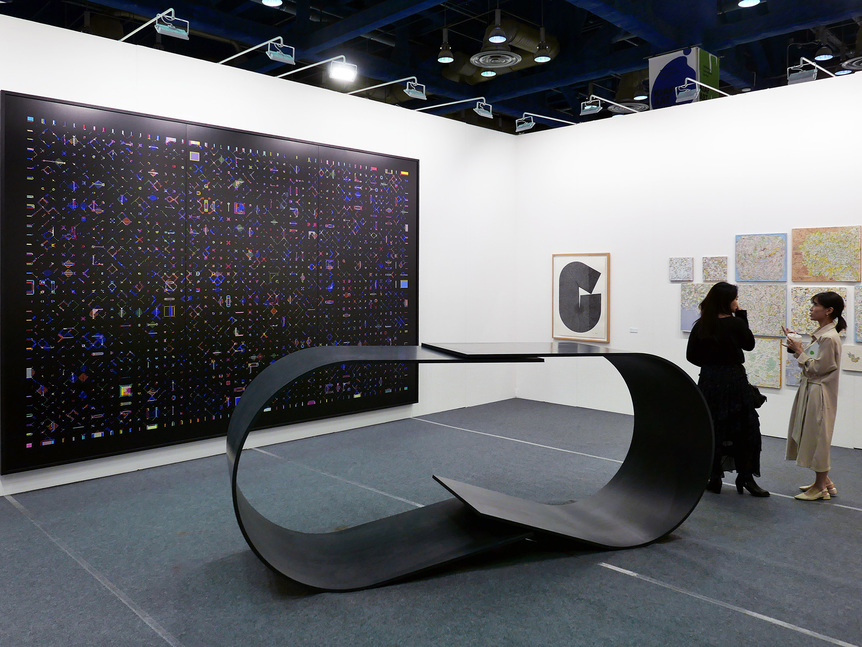
R
E
V N
E
X
T
Hall A at the COEX convention and exhibition center in Seoul in the opening hour of Korea International Art Fair, Seoul, 2019. All images by HG Masters for ArtAsiaPacific.
The 18th edition of the Korea International Art Fair (KIAF) kicked off its five-day run on September 25 in Seoul’s COEX convention and retail complex. The venue was bustling with well-suited lawyers in town for the International Bar Association’s annual conference, whereas the art crowd was harder to spot until Halls A and B, where the familiar white-walled booths were arrayed in wide rows beneath colorful KIAF banners hanging high above. This edition of the fair, organized by the Galleries Association of Korea, included 175 galleries from 17 countries and territories (mainland China, where Arario Gallery has a branch, was notably unrepresented) at the event.
Compared to other fairs in the region, KIAF’s VIP opening, from 3 PM to 8 PM, was relatively quiet. Collectors were seen checking in with galleries alongside well-known Korean artists having their pictures taken next to their latest works. By 7 PM, the crowd had thinned considerably. One gallerist explained that in general, buyers in Korea take their time, often holding off on final decisions until Sunday, when there is also the opportunity for special discounts.
The range of works was notable. Many of the smaller booths around the perimeters of both halls offered works in pop-inflected or street art styles with mass appeal, while the central aisles were occupied by large booths representing major international and Korean galleries. For instance, located at the four corners of the main axis near the entrance were Lehmann Maupin (New York/Hong Kong/Seoul), Pace Gallery (New York/London/Hong Kong/Seoul/Palo Alto/Geneva), Gallery Hyundai (Seoul), and Lee Hwaik Gallery (Seoul). Lehmann Maupin showed two vintage Lee Bul pieces next to Liza Lou’s minimalist installation of beaded forms. Pace went for a booth that emphasized the minimal abstraction of California’s “Light and Space” artists from the 1970s, with light installations by Robert Irwin and James Turrell, and Peter Alexander’s sculptural forms, in addition to a canvas by painter Kenneth Noland. Meanwhile, Hyundai created a maximalist presentation of Korean postwar artists, ranging from the video-sculptor Kim Hyunki to abstractions on paper by Kim Minjung, colorful paintings by Quac Insak, and white-on-white abstractions by Chung Sang-hwa. Further up the main aisle, Kukje Gallery (Seoul/Busan) showed a towering navy-blue abstraction by Ha Chong-hyun, and a pair of paintings with a black lotus motif on white-gold leaf by Paris-based Jean-Michel Othoniel. Hakgojae Gallery (Seoul) featured a Nam June Paik TV-sculpture, titled Robot (Radio Man, Joseph Beuys) (1978). Massimo de Carlo (Milan/Hong Kong) turned heads with Paola Pivi’s installation of a gigantic white polar bear sitting at an office desk.
In Hall B, Arario’s (Cheonan/Seoul/Shanghai) booth had a historical focus on three Korean artists: conceptual photographer Hwang Gyutae, minimalist sculptor Tai-Jung Um, and media artist Kim Soun-gui. In addition, the gallery exhibited a chandelier and video installation about Indonesian youth terrorist camps by Jompet Kuswidananto. Nearby, PKM Gallery (Seoul) emphasized works based on natural forms by Olafur Eliasson, along with Yun Hyong-Keun’s painterly abstractions, and Darren Almond’s landscape photographs. Next door, Whitestone Gallery (Tokyo/Karuizawa/Hong Kong/Taipei) showcased Gutai artists, with a mini canvas by Kazuo Shiraga and recent works by Tsuyoshi Maekawa, as well as 1980s flag-inspired abstractions by Tetsuo Mizù, and a live-painting performance by Ahhi Choi.
HG Masters is the deputy editor and deputy publisher of ArtAsiaPacific.
The 18th Korea International Art Fair is on view at COEX Hall A and B, Seoul, until September 29, 2019.
To read more of ArtAsiaPacific’s articles, visit our Digital Library.
















